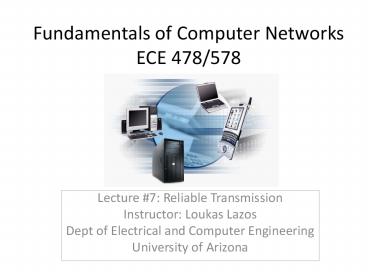Fundamentals of Computer Networks ECE 478/578 - PowerPoint PPT Presentation
1 / 15
Title:
Fundamentals of Computer Networks ECE 478/578
Description:
Fundamentals of Computer Networks. ECE 478/578. Lecture #7: Reliable Transmission ... Dept of Electrical and Computer Engineering. University of Arizona ... – PowerPoint PPT presentation
Number of Views:76
Avg rating:3.0/5.0
Title: Fundamentals of Computer Networks ECE 478/578
1
Fundamentals of Computer NetworksECE 478/578
- Lecture 7 Reliable Transmission
- Instructor Loukas Lazos
- Dept of Electrical and Computer Engineering
- University of Arizona
2
Reliable Transmission
- Transmission strategies under a lossless channel
- Simplex connection
- Simplex Stop-and-wait
- Transmission Strategies under a lossy channel
- Process of retransmitting frames that cannot be
corrected by CRC codes - Stop-and-wait
- Go-back-N
- Selective repeat
3
Simplex Protocol Lossless Channel
Sender
Receiver
- Data flows one direction only
- Communication channel never loses frames
- Receiver is always ready to receive packets
- Problem receiver can be flooded if it does not
process packets fast enough - Solution Introduce delay at sender
request
reply
negotiate
ack
. . .
4
Simplex Protocol Lossy Channel
- Stop-and-wait
5
Failure of the Stop-and-Wait
- ACK is lost or arrives after timeout
6
Solution based on Sequence No
- Use a one-bit sequence number on the header
Sender
Receiver
Frame 0
ACK
Frame 0
Frame 1
ACK
Frame 0
7
(In)Efficiency of Stop-and-Wait
- Example Consider 1.5Mbps link, 45ms RTT
- Delay x Bandwidth 67.5kb 8KB
- If frames are 1KB long then max rate
- 1024 x 8 /0.045 182Kbps
- Only 1/8th of links capacity
- Goal keep the pipe full, i.e. have maximum of
bits unacknowledged at any given time - Our example, we could have 8 frames
unacknowledged
8
Go-back-N Protocol
- Main idea Leave up to N frames unacknowledged at
any given time
9
Go-Back-N
- Each frame is assigned a SeqNum
- Variables at the sender
- SWS Send Window Size
- LAR Last Acknowledgment Received
- LFS Last Frame Sent
- Rule LFS LAR ? SWS (at most SWS frames
unACKed) - Variables at the receiver
- RWS Receive Window Size
- LAF Largest Acceptable Frame (in seq )
- LFR Last Frame Received
- Rule LAF LFR ? RWS
10
Sliding Window Depicted
- At the sender
- At the receiver
11
Updating Variables
Si
SWS
RWS
Receiver Variables LFRi LAFi
Sender Variables LSFi LARi
- Si LFRi1 (Go-back-N only accepts packets in
order) - Si ? LAFi (which is guaranteed in our case, for
RWS ? 1) - LSFi1 LSF 1, LFRi1 LFRi 1, LAFi1 LAFi
1 - Window at sender advanced only if ACK received
12
Example of Go-Back-N
Sender
Receiver
SWS 4
RWS 1
0
1
LFR 0 LAF 1
2
Timeout
3
LFS 4 LAR 0
4
discarded
1
2
- Max Sequence Number ? SWS 1
- Link does not re-arrange packets
13
Piggypacking
- Duplex communication, attach ACK on the reply
frame - Asymmetry in frame size can cause timeouts
- Go-Back-N can be turned into Stop-and-Wait
Sender
Receiver
14
Selective Repeat
- Window size can be very large for nets with large
delay x bandwidth - Inefficient to retransmit all N frames if one is
lost - Selective repeat allows the re-transmission of
only the lost packets - Accepts out-of-order packets
- Simply increase the RWS up to SWS (does not make
sense to allow for RWS gt SWS)
15
Example of Selective Repeat
Sender
Receiver
SWS 4
RWS 4
0
1
LFR 0 LAF 4
2
Timeout
3
LFS 4 LAR 0
4
Buffered
1
LFS 4 LAR 4
5
6
7
- Max Sequence Number ? 2 SWS































